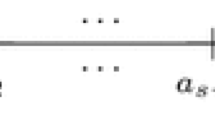Abstract
Research on multiple comparison ranking up to now has focused mainly on the comparison of preference in several objects (or items). This article presents a multiple comparison ranking procedure for comparing several scalar functions of parameters. A preference probability matrix for the procedure is introduced and its condition for warranting an optimal comparison ranking is studied. By using a Bayesian Monte Carlo method, we develop simulation-based procedure to estimate the matrix and obtain the optimal ranking via a row-sum scores method. The procedure is shown to be straightforward to specify distributionally and to implement computationally, with output readily adapted for required inference summaries. Necessary theory and illustrative examples are provided.
Similar content being viewed by others
References
Bauer P (1997) A note on multiple testing procedure in dose finding. Biometric 53: 1125–1128
Bechhofer RE, Santner TJ, Goldsman DM (1995) Design and analysis of experiments for statistical selection, screening, and multiple comparisons. Wiley, New York
Brandowski A (1980). Investigation of the safety of a ship propulsion system by Monte Carlo technique. In: Colombrai V (eds) Reliability data collection and use in risk and availability assessment. Springer, Berlin Heidelberg New York
David HA (1987) Ranking from unbalanced paired-comparison data. Biometrika 74:432–436
Geweke J (1989) Bayesian inference in econometrics models using Monte Carlo integration. Econometrica 57:1371–1340
Harris B, Soms AP (1973) The reliability systems of independent parallel components when some components are repeated. J Am Statist Assoc 68: 894–898
Kenneth VD, John SD, Kenneth JS (1998) Incorporating a geometric mean formula into CPI. Mon Labor Review, October, 2–7
Kim S, Nelson BL (2001) A fully sequential selection procedure for indifference-zone selection in simulation. Trans Model Comput Simul 11:251–273
Leemis LM, Trivedi KS (1996), A comparison of approximate interval estimators for Bernoulli parameter. Am Statis 50:63–68
Liu W, Jamshidian M, Zhang Y (2004) Multiple comparison of several linear regression models. J Am Statist Assoc 99:395–403
Mann NR, Schafer NR, Singpurwalla ND (1974) Methods of statistical analysis of reliability and life data. Wiley , New York
Sun D, Ye K (1995) Reference prior Bayesian analysis for normal mean. J Am Statist Assoc 90:589–597
Tibshirani R (1989) Noninformative priors for one parameter of many. Biometrika 76:604–608
Yfantis EA, Flatman GT (1991) On confidence interval for the product of three means of three normally distributed populations. J Chemometrics 5:309–319
Author information
Authors and Affiliations
Corresponding author
Rights and permissions
About this article
Cite this article
Kim, HJ. A computational method for ranking L products of parameters. Computational Statistics 21, 473–485 (2006). https://doi.org/10.1007/s00180-006-0007-y
Published:
Issue Date:
DOI: https://doi.org/10.1007/s00180-006-0007-y




